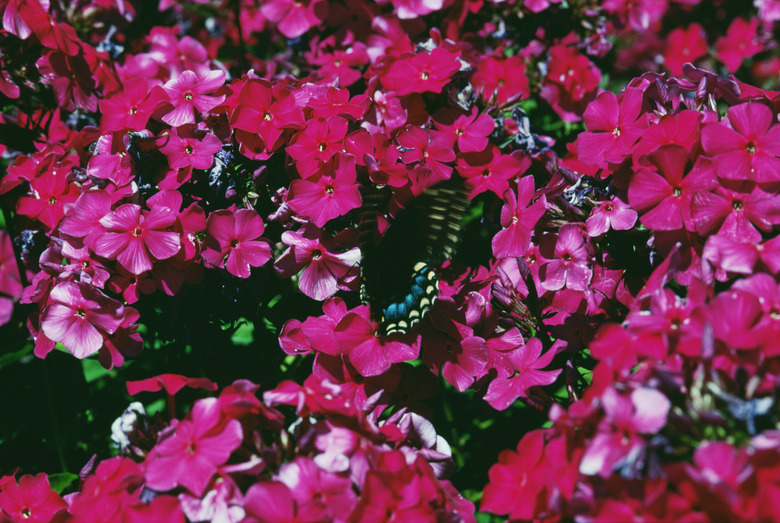How Far Should I Cut Tall Phlox Down In Winter?
Tall garden phlox (Phlox paniculata) is an old-fashioned beauty cultivated by generations of gardeners. The plant, perennial in U.S. Department of Agriculture plant hardiness zones 3 through 8, is an attractive middle-of-the-border plant for full sun that grows from 2 to 3 feet tall and blooms for as long as six weeks from late summer into fall. As temperatures drop going into winter, cut phlox back for a healthier plant in the spring.
End-of-Season Pruning
Step 1
Healthy phlox plants can be cut back by half after the flowers fade from late summer to fall to prevent reseeding. Seedlings from named cultivars revert to the magenta pink of the plain species plant. Phlox is prone to the disease powdery mildew, which disfigures the plants from the bottom up, covering them in a whitish powder. Cut infected plants back to the ground for winter with pruning shears.
- Tall garden phlox (Phlox paniculata) is an old-fashioned beauty cultivated by generations of gardeners.
- Healthy phlox plants can be cut back by half after the flowers fade from late summer to fall to prevent reseeding.
Powdery Mildew
Step 1
Powdery mildew, caused by a fungus (Erysiphe cichoracearum), often strikes tall phlox in midsummer. It begins as white, powdery patches on foliage, which can merge and eventually cover all the green on the plant. The disease is prevalent in areas with high humidity and where plants are shaded and frequently watered overhead in the evening, which doesn't give the foliage a chance to dry before the temperatures cool. Some tall phlox cultivars are bred to be resistant to the disease, and the plain species plant is more resistant than named cultivars. Rake up and discard all pruned material in the trash — not in a compost pile — to avoid spreading the fungus or letting it overwinter to reinfect the plant when it reemerges in the spring.
Preventive Pruning
Step 1
Pruning early in the season cuts the chances that your phlox plants will develop powdery mildew. When the plants are about 6 inches tall in the spring, thin the plant to five or six of the healthiest stems, spread across the plant. Cut the other stems out at the base with bypass pruners. Pinching out the tips of the stems that remain encourages branching to help the plant fill in at the top, while allowing for increased air circulation around the base, which discourages the fungal disease.
- Powdery mildew, caused by a fungus (Erysiphe cichoracearum), often strikes tall phlox in midsummer.
- Pinching out the tips of the stems that remain encourages branching to help the plant fill in at the top, while allowing for increased air circulation around the base, which discourages the fungal disease.
Considerations
Step 1
Use sharp, sterile pruning shears when cutting back your phlox. When the plant has a case of powdery mildew, resterilize the tool before using it to cut other plants. Household antiseptic cleaning spray can do the trick without damaging your clothing or the metal of the tool. Wear gloves to protect your hands from inadvertent cuts or from soil-borne disease. Keep pruning tools out of reach of children. Phlox are nontoxic and considered safe for planting around children and pets.
References
- University of Illinois Extension: Garden Phlox, Phlox Paniculata
- University of Minnesota Extension: Tall Garden Phlox for Minnesota Gardens
- Viette's Views: Keep the Winter Garden in Mind This Fall
- University of Illinois Extension: To Prune or Not to Prune — Perennials
- California Poison Control: Know Your Plants
